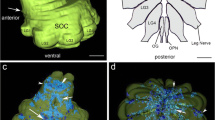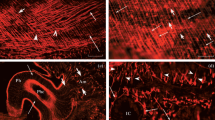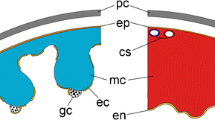Abstract
Squid chromatophores are organs of colour change, consisting of a pigment sac opened by contraction of 10–24 radial muscle fibres. The ultrastructure and innervation of these muscle fibres were examined by electron microscopy and diagramatic reconstructions made on the basis of serial ultra-thin sections. At the proximal end of the fibre, nearest the pigment sac a cortical myofilament zone surrounds 2 cores containing mitochrondria; further along the fibre these merge to form one central core. The myofilament zone forms a groove containing a nerve bundle consisting of 2 to 4 axons per muscle fibre. The axons are surrounded by glial cell processes, and either originate from a neighbouring fibre, or join the fibre at some point along its length. Axons twist around each other, forming a series of synapses with the muscle fibre. As many as 6–37 synapses exist along the length of each muscle fibre; the mean synapse interval is 9.05 μm, but the largest may be 123 μm. At the distal end of the muscles, the nerve is located towards the middle of the fibre, which it penetrates as the muscle splits up. Electron-lucent vesicles are present in all synaptic regions, but electron-dense vesicles are only found towards the distal end of the fibre. There is thus a possibility that more than one neurotransmitter is present in the nerves innervating chromatophores. Electron-lucent and dense-cored vesicles are not colocalised.
Similar content being viewed by others
References
Beaudet A, Descarries L (1987) Ultrastructural identification of serotonin neurons. In: Steinbusch H (ed) Monoaminergic neurons: light microscopy and ultrastructure. Wiley, New York
Bone Q, Howarth J (1980) The role of L-glutamate in neuromuscular transmission in some molluscs. J Marine Biol Ass UK 62: 193–199
Boycott BB (1953) The chromatophore system of cephalopods. Proc Linnean Soc Lond 164: 235–240
Bozler E (1928) Über die Tätigkeit der einzelnen glatten Muskelfaser bei der Kontraktion. 2. Mitt. Die Chromatophorenmuskeln der Cephalopoden. Z Vergleichende Physiologie 7: 379–406
Cloney RA, Brocco SL (1983) Chromatophore organs, reflector cells, iridocytes and leucophores in cephalopods. Am Zool 23: 581–592
Cloney RA, Florey E (1968) Ultrastructure of chromatophore organs. Z Zellforschung 9: 250–280
Cornwell CJ (1990) The innervation of cephalopod chromatophores. PhD thesis, University of Sheffield, UK
Cornwell CJ, Messenger JB (1995) Neurotransmitters of squid chromatophores. In: Abbot NJ, Williamson R, Maddock L (eds) Cephalopod Neurobiology. Oxford University Press, Oxford, pp 369–379
Dubas F, Hanlon RT, Ferguson GP, Pinsker HM (1986) Localisation and stimulation of chromatophore motoneurons in the brain of the squid, Lolliguncula brevis. J Exp Biol 121: 1–25
Fawcett P (1966) An atlas of fine structure: The cell, its organelles and inclusions. Saunders, Philadelphia London
Florey E (1966) Nervolus control and spontaneous activity of the chromatophores of a cephalopod, Loligo opalescens. Comp Biochem Physiol 18: 305–324
Florey E (1969) Ultrastructure and function of cephalopod chromatophores. Am Zool 9: 429–442
Florey E, Kriebel ME (1969) Electrical and mechanical responses of chromatophore muscle fibres of the squid Loligo opalescens to nerve stimulation and drugs. Z Vergleichende Physiologie 65: 98–130
Froesch D, Messenger JB (1978) On leucophores and the chromatic unit of Octopus vulgaris. J Zool 186: 163–173
Graziadei P (1966) The ultrastructure of motor nerve endings in the muscle of cephalopods. J Ultrastruc Res 15: 1–13
Hanlon RT (1982) The functional organisation of chromatophores and iridescent cells in the body patterning of Loligo pealei (Cephalopoda: Myopsida). Malacologia 23: 89–119
Hess A (1965) The sarcoplasmic reticulum, the T system, and the motor terminals of slow and twitch muscle fibres in the garter snake. J Cell Biol 26: 467–497
Hofmann FB (1907) Histologische Unterschungen über die Innervation der glatten und der ihr verwandten Musculatur der Wirbeltiere und der Mollusken. Archiv für mikroskopische Anatomie 70: 361–413
Holmes W (1955) The colour changes of cephalopods. Endeavour 14: 78–82
Jack JJB, Redman SJ, Wong K (1981) The components of synaptic potentials evoked in cat spinal motoneurones by impulses in single group Ia afferents. J Physiol 321: 65–96
Kawaguti S, Mabuchi P (1970) Electron microscopy on the chromatophore muscle in cephalopods. Biol J Okayama University 16: 1–10
Kuffler SW, Nicholls JG, Martin AR (1984) From Neuron to Brain. 2nd edn. Sinauer, Sunderland, Massachusetts
Lewis PR, Knight DP (1977) Staining methods for sectioned material. In: Glauert AM (ed) Practical methods in electron microscopy. North-Holland, Amsterdam, pp 25–68
Millonig GT (1961) A modified procedure for lead staining of thin sections. J Biophys Biochem Cytol 11: 736–739
Mirow S (1972) Skin colour in the squids Loligo pealei and Loligo opalescens. I. Chromatophores. Z Zellforschung 125: 143–175
Packard A (1982) Morphogenesis of chromatophores in cephalopods: are morphological and physical units the same? Malacologia 23: 193–201
Ridge MA (1971) Different types of extrafusal muscle fibres in snake costocutaneous muscles. J Physiol 217: 393–418
Ryan K (1981) Block preparation for ultramicrotomy enabling tocation and photography of feature, alignment of section plane and mesa production. Mikroscopie 38: 81–84
Weber W (1973) Peculiarities in innervation in chromatophoe muscle cells of Loligo vulgaris. Marine Biology 19: 224–226
Williams LW (1909) The anatomy of the common squid. E.J. Brill, Leiden, Holland
Author information
Authors and Affiliations
Additional information
This work was carried out during the tenure of a BBSRC CASE studentship
Rights and permissions
About this article
Cite this article
Reed, C.M. The ultrastructure and innervation of muscles controlling chromatophore expansion in the squid, Loligo vulgaris . Cell Tissue Res 282, 503–512 (1995). https://doi.org/10.1007/BF00318882
Received:
Accepted:
Issue Date:
DOI: https://doi.org/10.1007/BF00318882




